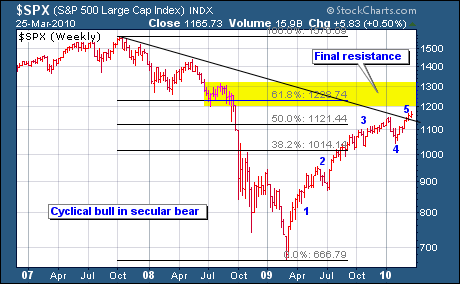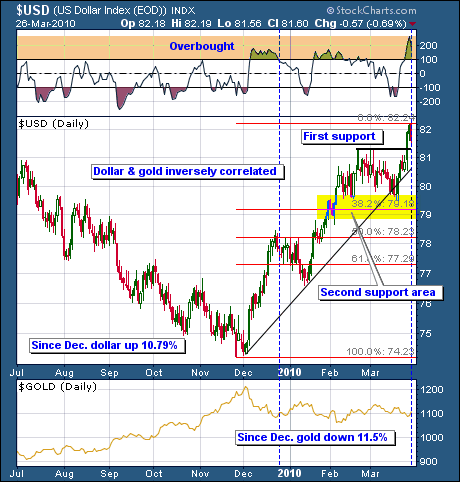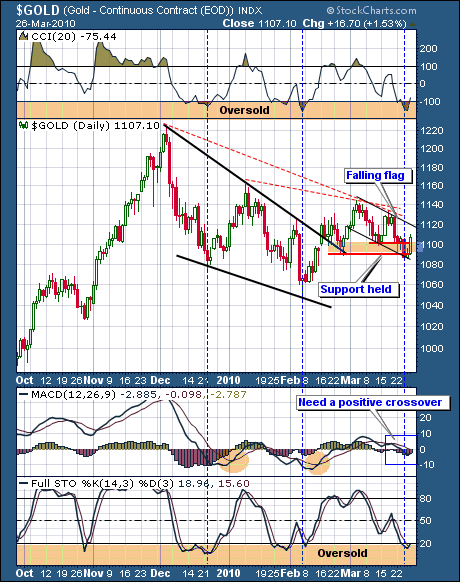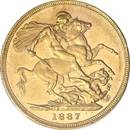Interest Rates Surge Higher on Debt Crisis, Stock Market Dow Non-Confirmation
Stock-Markets / Financial Markets 2010 Mar 30, 2010 - 03:17 AM GMT The big news this week was the rise in interest rates, especially on the long end of the yield curve: 10 year yields were up 16 basis points to 3.85%; and 30 year rates added 17 basis points to 4.75% (see charts in the bond section). What’s behind this sudden move?
The big news this week was the rise in interest rates, especially on the long end of the yield curve: 10 year yields were up 16 basis points to 3.85%; and 30 year rates added 17 basis points to 4.75% (see charts in the bond section). What’s behind this sudden move?
It appears there may be other sovereign debt problems lurking in the shadows besides Greece. For the past several weeks, Greece’s debt crisis has held center stage in the global arena. Now, attention is shifting to the European Union’s response thereto.
Will Europe stand by Athens and offer financial support, or will they defer to the International Monetary Fund (IMF)? European Central Bank President Jean-Claude Trichet seems confused, first saying:
“If the IMF or any other authority exercises any responsibility instead of the euro group, instead of the governments, this would clearly be very, very bad.”
 After receiving a good deal of flack for his statement, he changed in mid-stream saying: I am “extraordinarily happy that the governments of the euro area found out a workable solution.”
After receiving a good deal of flack for his statement, he changed in mid-stream saying: I am “extraordinarily happy that the governments of the euro area found out a workable solution.”
He was referring to the EU’s endorsement of a Franco-German proposal that includes a combination of IMF and bilateral loans at market interest rates. For the moment all is quiet on the western front, as the euro responded with a relief rally (see currency section).
Greece’s sovereign debt problems are the tip of the iceberg. In Europe, Spain, Portugal, Italy and even Great Britain are all up to their eye balls in debt. The US is not far behind, which is why interest rates went up this week.
The Treasury Department held huge debt auctions this week, and buyers demanded more interest for the increased risks. It’s no secret that the US has a huge supply of debt to sell to finance the deficits and other bailout schemes.
The entire world is flooded in a sea of debt. One nation after another will be called to task, as the piper demands payment. A game of currency debasement is taking place worldwide, as governments try to pay off debt, without destroying foreign trade.
Stocks
Stocks continued to forge ahead, with the S&P adding another 6.69 points to close at 1166.59. Most of the major market indices made new 52 week highs this week.
Although the dollar has moved higher over the last couple of weeks, it has had no ill effects on stocks – so far.
So far, little, if anything, has slowed the markets rise. The trillions of dollars of liquidity the Fed has injected into the system have caused an asset-inflated bubble in stocks.
This in turn has resulted in a cyclical bull market during what may turn out to be the worst secular bear market in history. Below are two charts that show different wave counts since the 2008 crisis and fall. There are other counts and interpretations besides these. Any of them could be right – or wrong, so caveat emptor.

The one item that each chart or wave count has in unison is the 62.8% Fibonacci retracement level marking the end of the rally.
Please note the above wave counts are subjective in nature and are based on my interpretation of the charts, which could be way off.

Others have different opinions and different counts with different outcomes derived therefrom. Personally (subjective speculation), I believe we are much closer to the end of this rally than the beginning.
In keeping with the premise of a cyclical bull market within a secular bear market, Dow Theory has flashed yet another non-confirmation. Several weeks ago I wrote about the non-confirmation of the Industrials with the new high by the Transportation Average.
The very next week the Industrials responded and made a new high. Thus the non-confirmation was resolved with a positive confirmation.
Since the above confirmation, the Industrials have gone on to make two new recovery highs, neither of which have been confirmed by the Transports. In fact, as the chart below shows – the Transports have been declining.

This divergence in of itself is nothing more than a warning sign to pay attention. It is how the non-confirmation is resolved in future price action that is important.
As we recently saw – the Transports may simply turn back up and confirm with a new high. However, if both averages turn down from here and break below their prior reaction lows, then we will have another nail in the coffin of the bear market rally – a Dow Theory non-confirmation that holds and is validated.
Returning to the present market, we have the daily SPY chart below. What stands out the most on the chart is not only the strength of the entire rally, but the steepness of the ascent since Feb. That is a near parabolic rise – one that is hard to sustain.
Gold recently showed what happens after parabolic rises that have little underlying support along the way: the forces of gravity pull such rises back to earth, almost as suddenly as they went up.
Support areas are marked. Note the past breaks below 100 CCI and subsequent corrections that followed. The intermediate term trend would not change until the 109 support area is broken below.

Currency
The dollar continues to rally, while the euro continues to fall; although the euro received a bit of respite at the end of the week, with the release that the EU and IMF may join in offering support to Greece.
 The euro has been steadily falling since Dec. 2009. From Feb. to mid-March it looked like the euro was carving out a bottom, but the pressure from Greece’s sovereign debt problems was more than it could bear, and it broke down to new lows.
The euro has been steadily falling since Dec. 2009. From Feb. to mid-March it looked like the euro was carving out a bottom, but the pressure from Greece’s sovereign debt problems was more than it could bear, and it broke down to new lows.
Greece’s debt crisis is bringing warranted attention to the viability of the EU and especially of the regional euro currency. In my opinion, this was simply a prototype for a one world currency.
If you read the Maastricht Treaty carefully, you’ll see that the member states surrendered their individual sovereignty to a supra-transnational entity: the European Union. This is a prototype for one world government.
The entire idea of a one world fiat currency, issued by an elite one world government is flawed in many areas, too numerous to delve into here. For those interested in further details see my book: Honest Money. One entire chapter is devoted to this topic.
Nonetheless, for the week the dollar gained a little over 1%, to close at 81.60; while the euro lost a bit less than 1%, to close at 134.10. Intra-week the euro was considerably lower, hitting a low of 132.69. The dollar hit an intra-week high of 82.24. The chart below shows support for the dollar near 81.40. If price breaks below this level, then a retracement to the first Fib level around 79 is likely.
Considering the dollar is overbought – a pullback is likely.
However, the markets are running on pure adrenaline, so anything is possible. Notice that since the dollar rally began in Dec. it has gained 10.79%; while gold has declined 11.5% during the same time-frame.

There are several more currency charts with detailed analysis in the full market wrap report.
 Gold
Gold
Gold was essentially unchanged for the week, adding 0.30 cents to close at $1107.10 (continuous contract). It was encouraging to see gold hold positive territory while the dollar was up over 1%.
Last week I stated that gold was testing important support going back to its earlier March low and its Feb. breakout from the falling wedge pattern (see chart below). Although prices remain little changed from last week, intra-week gold did fall and test the lows, and so far they have held. Further confirmation is needed, however.
I also said in last week’s report that gold was sitting on the fence, and that it could go either way: up or down. It appeared that the path of least resistance was down. With Friday’s long white candlestick (see chart below) the weight of the evidence has shifted back to even. Let’s wait for the market to tip its hand this week.
The daily chart shows that gold is somewhat oversold, according to both CCI and STO. Notice that the CCI indicator has moved from below -100, to just above this trigger level, and is presently sitting at -75.
Follow the blue vertical dotted lines that connect past CCI signals with subsequent price rallies and oversold STO readings at the bottom of the chart.
Note that for these buy signals to be valid that STO needs to move from below 20 to above; and that both the CCI & STO signals need to be confirmed with a positive MACD crossover.
So far, only CCI has given a signal. STO has not yet moved above 20 and MACD is presently under a negative crossover and has a ways to go before making a positive crossover.
For gold’s outlook to turn positive it needs to break above the falling flag formation & hold the breakout.
The full market wrap report contains several more charts (saved for full-time subscribers). An important price channel has formed on the weekly chart.

The above excerpt is from the latest full-length market wrap report, available on the Honest Money Gold & Silver Report website. All major markets are covered: stocks, bonds, currencies, and commodities, with the emphasis on the precious metals.
If you would like to read a weekly comprehensive report that covers all these issues and more, including dozens of charts & graphs each week, we invite you to try a FREE trial subscription.
Stop by and check it out. Our stock watch list provides numerous investment ideas each week and the model portfolio offers a game plan to implement them. There is no obligation to continue your subscription and the free book and other materials are yours to keep.
Good luck. Good trading. Good health, and that’s a wrap.

Come visit our website: Honest Money Gold & Silver Report
New Audio-Book Now Available - Honest Money
Douglas V. Gnazzo
Honest Money Gold & Silver Report
About the author: Douglas V. Gnazzo writes for numerous websites and his work appears both here and abroad. Mr. Gnazzo is a listed scholar for the Foundation for the Advancement of Monetary Education (FAME).
Disclaimer: The contents of this article represent the opinions of Douglas V. Gnazzo. Nothing contained herein is intended as investment advice or recommendations for specific investment decisions, and you should not rely on it as such. Douglas V. Gnazzo is not a registered investment advisor. Information and analysis above are derived from sources and using methods believed to be reliable, but Douglas. V. Gnazzo cannot accept responsibility for any trading losses you may incur as a result of your reliance on this analysis and will not be held liable for the consequence of reliance upon any opinion or statement contained herein or any omission. Individuals should consult with their broker and personal financial advisors before engaging in any trading activities. Do your own due diligence regarding personal investment decisions. This article may contain information that is confidential and/or protected by law. The purpose of this article is intended to be used as an educational discussion of the issues involved. Douglas V. Gnazzo is not a lawyer or a legal scholar. Information and analysis derived from the quoted sources are believed to be reliable and are offered in good faith. Only a highly trained and certified and registered legal professional should be regarded as an authority on the issues involved; and all those seeking such an authoritative opinion should do their own due diligence and seek out the advice of a legal professional. Lastly Douglas V. Gnazzo believes that The United States of America is the greatest country on Earth, but that it can yet become greater. This article is written to help facilitate that greater becoming. God Bless America.

Douglas V. Gnazzo © 2009 All Rights Reserved
© 2005-2022 http://www.MarketOracle.co.uk - The Market Oracle is a FREE Daily Financial Markets Analysis & Forecasting online publication.



